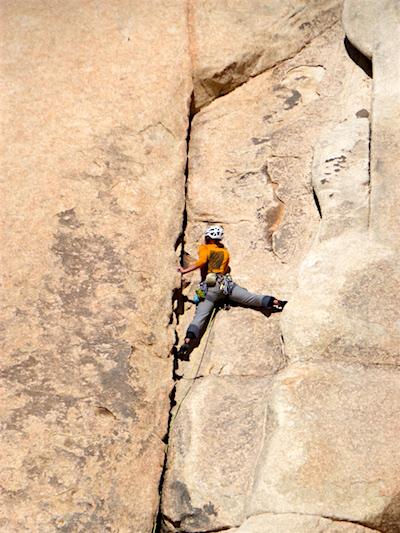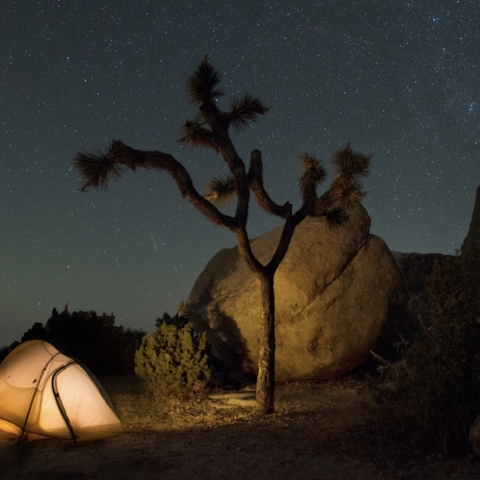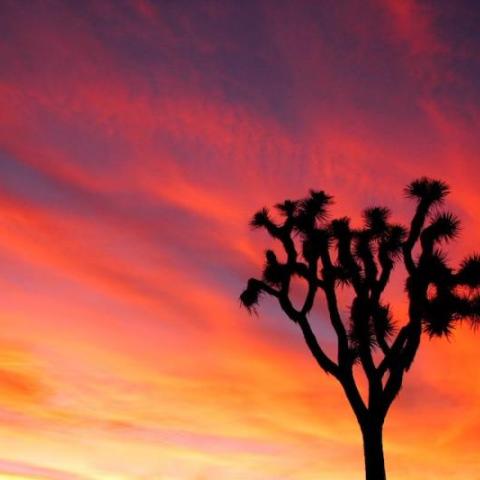We recently returned to southern California’s Joshua Tree National Park for a third time. The previous visits took place a number of years ago and were rushed affairs when we were headed for other destinations. In each case we made a short stop at the park’s Oasis Visitor Center just outside the town of Twentynine Palms and drove south through the park to Interstate 10 without another stop of any consequence. Mostly, we were there to see the unusual trees (actually, they aren’t trees) that serve as the park’s namesake with little time for exploration. Unfortunately, we missed the largest concentration of trees and failed to appreciate much of what Joshua Tree National Park has to offer. That was our loss.
During the most recent trip we spent two nights in Twentynine Palms so as to be able to devote a full day to the park. We took our time at each of the visitor centers, enjoyed an outdoor ranger presentation, visited several of the campgrounds, got painfully pricked by a jumping cactus during a walk (Yes, it is frequently called jumping cactus), and watched as rock climbers scaled some of the park’s impressive granite boulders. We also saw a large number of the park’s many Joshua trees. It was a beautiful sunny day in early November, but breezy enough that we nearly got blown away while standing on the high overlook at Keys View.
Individuals have often described Joshua trees as ugly, but we have always found them interesting. The odd-shaped stick figures offer an opportunity for your imagination to run the gamut in trying to figure out what that shape of each plant resembles. According to one story, the plant was named by Mormons who felt the trees resembled Joshua pointing the way to heaven.
Joshua trees are pollinated only by yucca moths that lay their eggs in the trees’ flowers. The larva then feed on seeds as the fruit matures. The average lifespan of the plants is approximately 150 years, although there is concern that a warming climate is resulting in much shorter lives for Joshua trees at lower elevations.
The Birth of Joshua Tree National Park
Joshua Tree National Park owes its existence to land developers who wanted to make a buck and California residents who were intent on improving their personal landscaping at low cost by poaching vegetation. These were the culprits that caused Pasadena resident and socialite Minerva Hoyt to become a force for preserving the desert landscape. Mrs. Hoyt served on a California commission that recommended proposals for new state parks and was the founder of the International Deserts Conservation League. She was considered important enough that she was introduced to President Franklin Roosevelt and became acquainted with Secretary of the Interior Harold Ickes.
Mrs. Hoyt grew up in Mississippi during the Civil War Reconstruction Era but moved to Southern California after marrying, and there she fell in love with the desert. It was during trips into the desert to collect plants for her gardens that she not only came to appreciate the desert vegetation, but saw the careless destruction of the land by those who viewed the Joshua trees and other cacti as worthless.
Not only did Mrs. Hoyt stage exhibitions of desert vegetation in places such as Boston, New York, and London in the late 1920s, but she founded the International Deserts Conservation League with the intention of preserving desertscapes. The attention she garnered through these efforts led Frederick Law Olmsted Jr., the noted landscape architect, to appoint her to a commission to recommend new state parks for California.
It was Mrs. Hoyt's belief that the National Park Service was best suited to preserve large swaths of desert that spurred her campaign to have the Joshua Tree area set aside as part of the National Park System. Her work led to her introduction to President Franklin Roosevelt and a friendship with his secretary of the Interior, Harold Ickes.
The park was established as a national monument by President Franklin Roosevelt who signed a presidential proclamation on August 10, 1936. At the time, the monument comprised 825,000 acres, a reduction from the original proposal of over a million acres. The monument was upgraded in 1994 to national park status at the same time 234,000 acres of land were added. Approximately 75 percent of the park’s nearly 800,000 acres are designated as wilderness.

Winter months are the prime season for climbing in Joshua Tree National Park due to the mild temperatures/David and Kay Scott
The 1994 expansion of the park resulted in new boundaries that encompassed elevations that ranged from 900 feet to over 5,000 feet which, in turn, covered three major ecosystems. The southern and eastern sections are part of the Colorado Desert, while the northern portion of the park consists of the southern reaches of the Mojave Desert. Higher elevations in the western section of the park exhibit a mountainous ecosystem.
Joshua Tree Today
Despite annually welcoming nearly 1.6 million visitors to a park almost one-third the size of Yellowstone, Joshua Tree doesn’t seem particularly crowded. At least that was the case during our early November visit. Pullouts at wayside exhibits offered empty parking spaces and roads throughout the park exhibited none of the congestion that is fairly common in many of the more popular parks. The lack of congestion is due in large part to the California park’s visitation being more evenly spread throughout the year, compared to many other National Park System units that experience especially heavy visitation during a limited number of summer months. Rather than a short summer season, Joshua Tree enjoys an extended season that runs from fall all the way through spring. Only the hot summers deter the public from visiting the southern California desert.
Joshua Tree National Park has nine campgrounds, only three of which have potable water, scattered about the park. The campgrounds are first-come, first-served except for two locations that offer reserved sites during the busy season of October through May. Park campgrounds appeared to be nearly full during our visit, but this was a Friday blessed with sunny skies and moderate temperatures. Many of the sites are nicely spaced so campers didn’t appear crowded. Campgrounds situated in boulder fields interspersed with Joshua trees offered campers quite a bit of privacy and some outstanding scenery.
Getting Around the Park
The park’s main roads are laid out in a wiggly Y-shape with entrances on the northwest, north, and south. Modest visitor centers are near each entrance. Based on our own visit we recommend spending the majority of time in the northern and western sections of the park. These are scenic areas that serve as home for the Joshua trees that prefer the cooler climate of the Mojave Desert.
Enter through the north entrance at the town of Joshua Tree after a stop at the Oasis Visitor Center to gather information and plot an itinerary. This is also the location for park headquarters. Drive south on Park Boulevard, take a left on Pinto Basin Road, and drive as far as the Cholla Cactus Garden. Stop for a walk through the garden where you will encounter the infamous “jumping cactuses.” These appear harmless and can be quite beautiful as they glisten in the sunlight, but don’t touch one! These are bad dudes! The tips of the spines have microscopic barbs that will penetrate shirts, pants, jackets, shoes, and, unfortunately, skin. The spines are very difficult to remove and quite painful to pull out of the skin.
After enjoying a stroll through the garden, return north and take a left on Park Boulevard and head west to Cap Rock. At Cap Rock take another left toward the dead end at Keys View, a splendid overlook with views of the valley, mountains, and desert. On a clear day, of which there are many, the San Andreas Fault that parallels the southwest border of the park can be observed.
Returning north from Keys View, turn west on Park Boulevard that leads to the park’s west entrance station. Near the intersection with Park Boulevard, Hidden Valley offers a one-mile loop trail through a scenic area of large boulders. Also, nearby is a spur road that leads to Keys Ranch, the former home

The path through the Cholla Cactus Garden provides close-up views of these interesting cacti...just don't get too close!/David and Kay Scott
of Bill and Frances Keys who lived here for 60 years. The site includes the ranch house, school house, store, and workshop, along with cars, trucks, and mining equipment that were once used here. Park rangers offer weekend tours of the ranch (fee charged) from mid-October to late-January. Reservations are required and can be obtained by calling (760) 367-5522 between 9 a.m. and 4:30 p.m.
Overview of an Interesting Park
The natural environment of Joshua Tree National Park is a stark contrast to our home in humid and green south Georgia. Perhaps that is one of the reasons we enjoyed our visit to the park so much. It was also nice to spend time in a national park without the traffic and crowds we seem to encounter in other popular parks. As an example, we were the only visitors present for the ranger talk at the Oasis Visitor Center. Our day in the park was so enjoyable another visit would certainly not be out of the question.





 Support Essential Coverage of Essential Places
Support Essential Coverage of Essential Places







Comments
Enjoyed your article! I have been visiting Joshua Tree National Park (formerly Monument) since I was a child. It has always been an interesting place to me. I especially enjoy the short hike around Hidden Vally where cattle rustlers are said to have hidden their stolen stock back in the early days. Every time I visit, I make sure I do that hike. When you come back, the hike to the Cottonwood Spring Oasis in the southern part of the park is also very nice, although I agree with you about favoring the northern and western portions of the park.